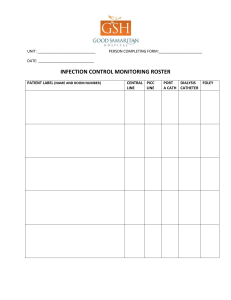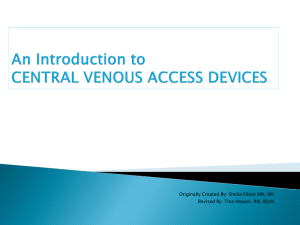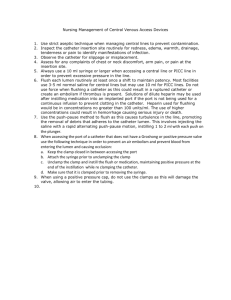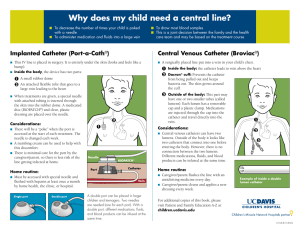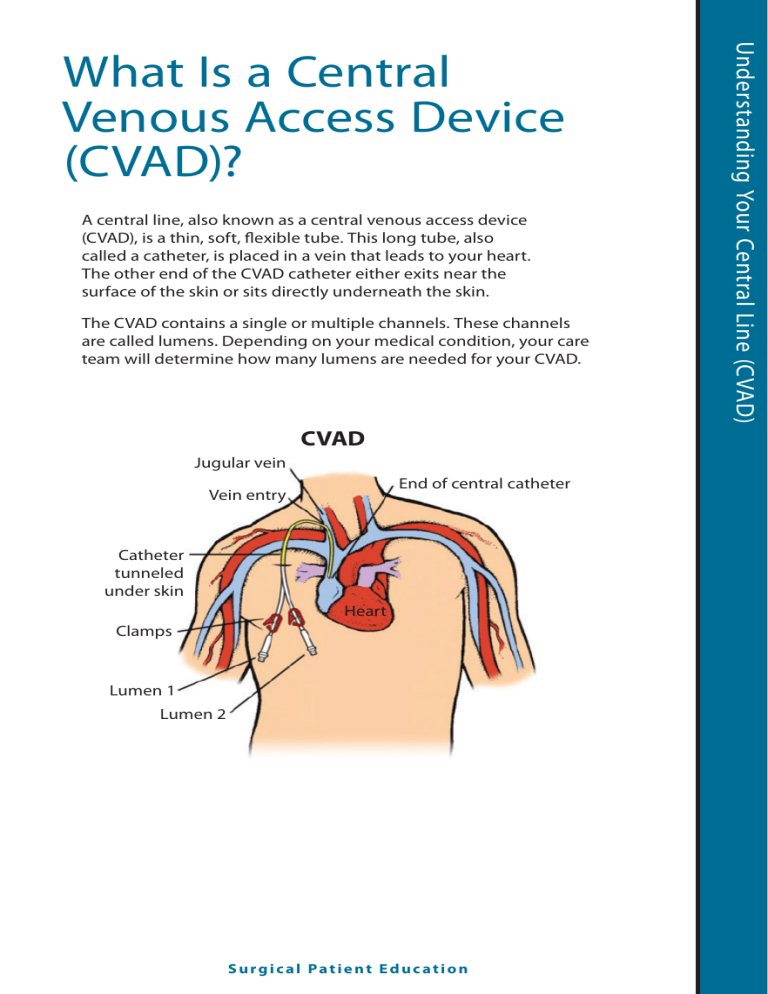
A central line, also known as a central venous access device (CVAD), is a thin, soft, flexible tube. This long tube, also called a catheter, is placed in a vein that leads to your heart. The other end of the CVAD catheter either exits near the surface of the skin or sits directly underneath the skin. The CVAD contains a single or multiple channels. These channels are called lumens. Depending on your medical condition, your care team will determine how many lumens are needed for your CVAD. CVAD Jugular vein End of central catheter Vein entry Catheter tunneled under skin Heart Clamps Lumen 1 Lumen 2 Surgical Patient Education Understanding Your Central Line (CVAD) What Is a Central Venous Access Device (CVAD)? Who Needs a Central Venous Access Device (CVAD)? Your doctor may suggest a central venous access device (CVAD) if a medical condition requires: ff Chemotherapy medication as part of your cancer treatment ff Long-term medications, such as antibiotics ff Frequent blood transfusions ff Hemodialysis ff Parenteral nutrition (PN) or total parenteral nutrition (TPN): nutrition given through a vein ff Frequent blood tests CVADs are used for long-term delivery of medication, nutrition, and fluids. A CVAD can stay in anywhere from a few months to years. Most are threaded under the skin, and the delivery tip is in a central vein far from the skin insertion site. This helps decrease the risk of infection and protects it from minor bumps and tugs. Since the vein is large, medicine and fluids given through a central line typically do not irritate the vein lining. While peripheral IV catheters are commonly used for most hospitalized patients, peripheral veins are smaller, lie close to the surface of the skin, and can easily be bumped or dislodged. Medicines can also irritate the lining of a peripheral vein. Peripheral IV catheters are best for short-term use. American College of Surgeons • Division of Education Understanding Your Circulatory System Since a central line goes into your vein and is placed near your heart, it’s helpful to have an understanding about your veins and how your circulation works. The movement of blood through the heart and around the body is called circulation. Your circulatory system is made up of your heart and blood vessels. The heart pumps blood through tubes called blood vessels. There are two main types of blood vessels: arteries and veins. Arteries carry blood away from the heart and deliver oxygen and nutrients to all of the cells. Veins return the blood to your heart to be pumped through your circulatory system again. A CVAD is a longer catheter with a tip that ends in a larger vein near the heart, usually the superior vena cava. Circulatory System Veins return the blood to the heart Arteries pump blood away from the heart Blood vessels going to lungs Superior vena cava Surgical Patient Education Understanding Your Central Line (CVAD) Central Venous Access Device (CVAD) Common Types of CVADs There are 3 common types of CVADs for home use: 1. Peripherally inserted central catheter (PICC) 2. Tunneled catheters (Broviac®, Hickman®, Leonard®, Groshong®) 3. Implanted ports (Port-a-Cath®) A hemodialysis catheter is another type of CVAD used only for patients receiving treatment for renal failure. It is used for dialysis access. See page 9 for more information. The size, location of the vein, and type of CVAD will depend on the specific reason you need the line. Let’s briefly review each catheter type. This will help you understand the care involved and will help you talk with your doctor about what might work best for you or your family member. Major Veins for CVAD Entry Jugular vein Subclavian vein Superior vena cava Cephalic vein Heart Basilic vein Femoral vein American College of Surgeons • Division of Education PICC Line Catheter tunneled through vein Vein entry Clamp Needleless connector A peripherally inserted central catheter (PICC) is placed through a puncture into the vein. Typically, it is inserted into a vein in the arm. In infants, a leg vein may be used. The PICC is advanced through larger veins toward the heart. The tip sits near the entry of the heart or the superior vena cava. The line can have one or more lumens that sit outside the body. PICC lines can be left in for months, and most people find them comfortable. The care of a PICC includes the following: ff Taking care of the tubing that lies outside your body. ff The entry site has to be covered at all times with a sterile dressing. ff The sterile dressing and needleless connector need to be changed at least every 7 days. ff The tubing has to be flushed regularly, sometimes daily. ff The entry site should not get wet—you must cover it during showering and bathing. ff The PICC can slip out, so you have to check it daily to make sure the tubing is secure and the length of the tubing has not changed. Surgical Patient Education Understanding Your Central Line (CVAD) P E R I P H E R A L LY I N S E R T E D C E N T R A L C AT H E T E R S ( P I C C ) T U N N E L E D C AT H E T E R S ( B R O V I A C , H I C K M A N , L E O N A R D, G R O S H O N G ) Tunneled CVAD Catheter Superior vena cava End of central catheter Subclavian vein Vein entry Catheter tunneled under skin Heart Exit site Clamp Needleless connector For a skin-tunneled catheter, a small cut is made on the chest, usually near the collarbone. The tip of the catheter is advanced into a large vein leading to the heart. The other end of the catheter is threaded under the skin and brought out through a small cut on the chest. Most catheters will contain a cuff that lies under the skin at the entry site. After placement, there will be a dressing over the insertion site. A tunneled catheter can be left in place for years with proper care. The care involved with a tunneled catheter includes: f The tubing lies outside the body on the chest. f The cuff helps secure the catheter, so it rarely slips out. f The sterile dressing and needleless connector are changed at least every 7 days. Once healed, catheters may not need a dressing. f The tube has to be flushed regularly, sometimes daily. Broviac CVAD with dressing and tubing looped up and secured to chest Needleless port Cuff Two lumens f The entry site should not get wet—you must cover it during showering and bathing. Catheter American College of Surgeons • Division of Education Understanding Your Central Line (CVAD) IMPLANTED PORTS Implanted Port (Port-a-Cath) Subclavian vein Vein entry Implanted port Incision site Heart An implanted port has an entry port that is a plastic or metal drum and a catheter that extends toward the heart. The port is surgically placed under the skin in the upper arm or chest wall. The catheter is in a large vein with the tip ending right outside the heart. The middle of the port has a soft, rubbery section where a needle can be inserted called the septum. Ports can have one or two septums. When your port is inserted, you will have stitches or a bandage over the site. Ports can stay in place for several years. Septum Line going to vein Noncoring needle Septum Port Catheter Single septum Surgical Patient Education Double septum The care involved with a port includes the following: ff There may be discomfort at the port site or shoulder after insertion, which could last for several weeks. You will need to work with your surgical team to plan the best location for the port. Backpack use, bra lines, seat belt use, and port access should all be discussed. ff When not used, the port is completely under the skin, and only a small bulge is visible. ff A special angled needle has to be inserted through the skin to give medication or fluids. Numbing medication may be placed over the port site before the needle is inserted. ff When the needle is in place, a sterile dressing covers the port site. ff There are fewer activity restrictions with a port. ff You may swim or shower without protection when the port is disconnected from a needle and tubing. Chest with noncoring needle inserted into the port and covered with a sterile dressing American College of Surgeons • Division of Education Jugular vein End of central catheter Vein entry Catheter tunneled under skin Heart Clamps Lumen 1 Lumen 2 A CVAD can be used temporarily for dialysis access. A common site for a hemodialysis CVAD is the internal jugular vein, located on the side of your neck. The catheter has two lumens that are used at the same time. One allows blood to flow out of the body to be cleaned during hemodialysis, and the other allows clean blood to return to the body. A CVAD is used for short-term hemodialysis or while your permanent site is healing. End tip (placed near heart) Cuff Clamps Venous lumen (carries blood to your heart) Arterial lumen (carries blood to dialysis machine) The care for a CVAD used for hemodialysis includes the following: ff Tubing sits outside the body, usually on the right side of your neck. ff Sterile dressings cover the site and are changed every 2 days if gauze is used and every 7 days for transparent dressings. Dressing changes are usually done during dialysis. ff Regular changing of the needleless connectors and flushing of the tubing are required. ff The entry site should not get wet—you must cover it during showering and bathing. Surgical Patient Education Understanding Your Central Line (CVAD) H E M O D I A LY S I S C VA D CVAD Insertion CVAD insertion will be different depending on the type of catheter and location. No matter the type of catheter you are receiving, you can expect your care team will obtain consent and review the reason for the procedure. An ultrasound test may be done to help find the largest and healthiest vein. A surgical safety check will be done to confirm the correct identification site and procedure. Infection prevention procedures will be used: f Your skin will be scrubbed with an antiseptic solution, and sterile cloths will be placed around the insertion site. f All team members will wear sterile gowns, gloves, masks, and hats. During the procedure, your medical team will make sure that you are comfortable. Numbing medication may be used around the placement site, and medicine may be given to help you sleep or relax. AFTER THE PROCEDURE The CVAD may be secured to your skin with a special holder, stitches, or glue. The CVAD or port site will be covered with a sterile dressing. An X-ray may be done to make sure the CVAD is in the correct location. American College of Surgeons • Division of Education Now that we’ve reviewed the different types of central line catheters, let’s discuss some of the specific parts and equipment you’ll be using. Soap or Hand Sanitizer If you use a hand sanitizer, be sure it is alcohol based. A hand sanitizer is only effective if it contains at least 60% alcohol. The alcohol evaporates within seconds as it dries. Gloves Use clean gloves each time you handle the needleless connector. You will use sterile gloves when doing dressing changes. Face Mask A face mask is worn when doing specific tasks, such as changing the CVAD dressing. Catheter Lumen and Needleless Connector Your CVAD or access port can have one or more lumens or tubing. You may hear your CVAD referred to as a single lumen, double lumen, or triple lumen. Each lumen is covered by a needleless connector. The connector helps keep bacteria from entering the lumen. The lumen tubing will have a clamp that should be closed when fluid is not going through it. Surgical Patient Education Understanding Your Central Line (CVAD) Skills Training: CVAD Equipment Antiseptic (Germ-Removing) Cleaning Solutions An antiseptic wipe is used to clean the needleless connector during dressing changes. An alcohol wipe is routinely used to clean the needleless connector. Chlorhexidine gluconate with alcohol (CHG) is routinely used to clean directly around the CVAD insertion site during dressing changes. It is also used to clean the skin. Chlorhexidine Chlorhexidine Squeeze Squeeze both sidesboth sides together together Antibiotics and Fluid Bags Some antibiotics are already mixed in a bag or bulb with sodium chloride or sterile water. Others come in a powder and you have to mix them right before you use them. That is because the medication is only effective for a limited time after it is mixed. Bulb Bag Clamps Clamps or clips are located directly on the CVAD tubing, usually right above the needleless connector and as part of the IV tubing. The clamp can be a clip clamp, rolling clamp, or sliding clamp. Clip clamp Rolling clamp Sliding clamp American College of Surgeons • Division of Education You are often given an emergency clamp to use in case the tubing breaks above the clamp site. Emergency clamp Dressing Change Kit The supplies for changing a dressing are often available as kits. The kit routinely contains a mask, gloves, alcohol wipes, sterile barrier, gauze, and a transparent dressing. Dressing change kit Flushing Syringes Each syringe has a needleless tip on one end and a plunger on the other. The tip is inserted into the needleless connector, and you empty the fluid from the syringe by pushing on the plunger. The syringe is most commonly filled with sodium chloride, also called normal saline. Flushing syringe Surgical Patient Education Understanding Your Central Line (CVAD) Clamp for Emergency IV (Intravenous) Fluids Fluids are given through your CVAD through a fluid bag. Dextrose (sugar) with electrolytes or sodium chloride (saline) are common fluids. IV TUBING WITH SPIKE AND INSERTION END IV tubing connects your fluid solution to your needleless connector. The tubing has 2 ends. The spike end is inserted into the bag of fluid. The other end is inserted into the needleless connector. All tubing includes a clamp that helps you control the flow of fluid. Some tubing contains a device so you can set how fast your fluid should flow. Spike Roller clamp Drip chamber Clip clamp Injection port M E D I C AT E D/A N T I M I C R O B I A L S P O N G E A soft, circular medicated sponge pad (Biopatch®) may be placed around the tubing at the entry site. Biopatch Biopatch® N O N CO R I N G I N FUSI O N N EED LE A right-angle noncoring needle is a special needle used to access the port of an implanted catheter. Tubing is attached to each noncoring needle, and the tubing includes a clamp and a needleless connector covering the access port. Noncoring needle Septum Port Catheter American College of Surgeons • Division of Education Parenteral nutrition, also called PN or TPN, is liquid nutrition given when you are not able to eat by mouth or feeding tube. It is sometimes yellow in color because of the vitamins that are added. The PN is attached to IV tubing and a special filter. STERILE DRESSING The access site is where the CVAD enters the body or where the angled needle enters the port. This should be covered with a sterile adhesive barrier or dressing. The barrier is water resistant and prevents bacteria from entering your site. SECUREMENT DEVICE A securement device (sometimes called a StatLock®) is often used with a PICC line to hold it in place. IV PUMP If the fluids are going to be given over several hours, you may be given an infusion (IV) pump. The pump allows you to program how much fluid you should be giving each hour. TOPICAL ANESTHE TIC FOR IMPL ANTED PORTS Topical anesthetic can be placed over the port site to numb the area. The numbing agent can be a cream or given as an injection with a tiny needle. Place the cream on the skin over the port entry site with a gloved hand 15 minutes to 1 hour before entry. Place a sterile occlusive dressing on top of the cream. Injections can be given right before needle insertion. Surgical Patient Education Understanding Your Central Line (CVAD) PA R E N T E R A L N U T R I T I O N

